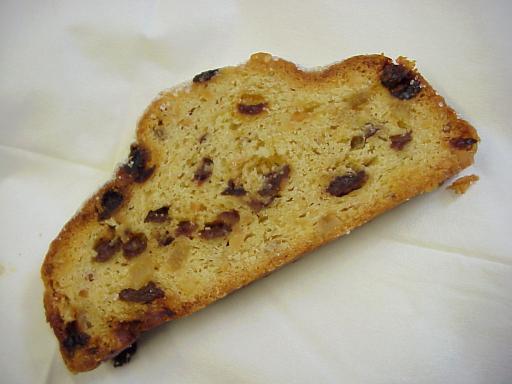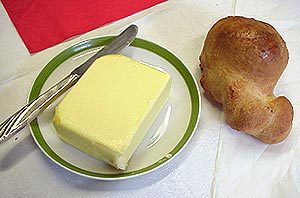 |
[ZAWiW] [gemeinsamlernen] [LiLL] | ||
|
|
||
| home | ||
|
|
Doris Becker | |
|
|
Ruth Dassler | |
|
|
Jutta Gotthart | |
|
|
Anneliese Haas | |
|
|
Erich Regula | |
|
|
Hildegard Keller | |
|
|
Lilo Nold | |
|
|
M.&H. Schwiebert | |
|
|
Brigitte Trojahn | |
|
|
Agathe Wende | |
 |
||
Anneliese Haas
Stand:Christstollen
Christstollen (Christmas bread) |
>>to the text "Wasserwecken (Bread rolls)" |

|
Annelise Haas  17.5.2002 17.5.2002
|
The speciality of baking Dresdner Christstollen goes back far in time. Some historians date back this tradition to the year 1400.
"Christstollen" was made of oatmeal and water and was dominated by church dogma. As the Stollen was made without
butter and milk, it was a tasteless pastry. Well up 1650 it was not allowed to use butter for baking because
before Christmas people had to fast.
The Earl from Sachsen and his brother begged the pope to give up the butter-prohibition. The request was heard on condition of paying penance. Some of this money was used to build the Freiburger cathedral.
During the past, the tradition of the Dresdner Christstollen was influenced by religious aspects. The form of the rolled Christollen shows a relationship to the wrapped up Jesus Christ in the cradle.
Today's Christstollen has got its excellent quality only in this century. It is due to the growing prosperity for large parts of the society. Christstollen is now exported into many countries. Even before the second world war Christstollen were sent in metal boxes across the ocean to Northern and Southern America.
In our family "Christstollen" was baked about 4 weeks before Christmas. During that time it smelt heavenly in the house. The Christstollen were packed and had to rest until Christmas to gain their delicious taste.
Quelle: http://www.stollen-online.de
Wasserwecken (Bread rolls)
The regional selections of bread rolls and other small bakery products is greater then that of bread. It is estimated that there are about 500 different specialities. The historical development of the different forms is influenced by the baked sacrificial offerings of our ancestors.
Christianity adopted these baking types and developed them further in the monastery bakeries. The oldest bread rolls sacrificed to the gods are 3000 years old. This was discovered by the scientist Dr. Max Währen.
|
The most famous traditional rolls in the area of Württemberg are the "Wasserwecken" (water buns). Here in Württemberg the bread rolls and buns were luxury. Until the turn of the century. Bread was eaten during the week and at the weekend the popular platted white yeast bred. The Wasserwecken was made preferably with "spelt"-flour, today with wheaten flour. At the weekends during my childhood we ate Wasserwecken that my father bought from a country bakery. These Wecken had a special crusty part, which made the right Wasserwecken. This was something very special for the family. |

|
